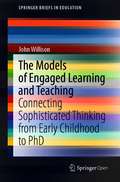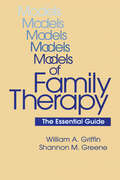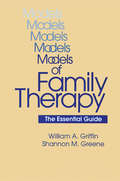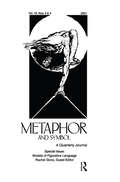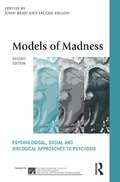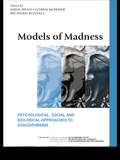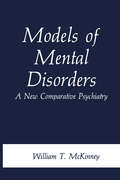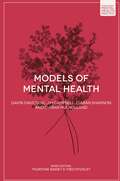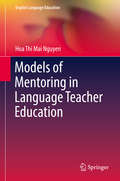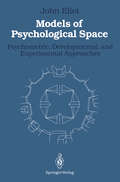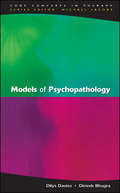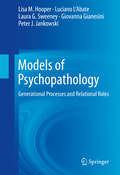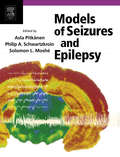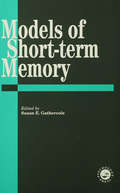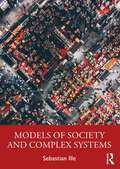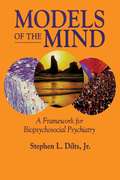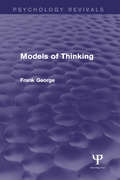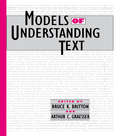- Table View
- List View
The Models of Engaged Learning and Teaching: Connecting Sophisticated Thinking from Early Childhood to PhD (SpringerBriefs in Education)
by John WillisonThis book provides a practical philosophy for promoting students' sophisticated thinking from Early Childhood to PhD in ways that explicitly interconnect across the years of education. It will help teachers, academics and the broader learning and teaching community to understand and implement these connections by introducing a conceptual framework, the Models of Engaged Learning and Teaching (MELT). By covering the nature, philosophy, practice and implications of MELT for teachers and students alike, the book will help teachers to facilitate students’ awareness of, and increasing responsibility for, the thinking demanded by subject and discipline-specific learning as well as interdisciplinary learning, whether face to face, online or in blended modes. The book will also provide educators with ways to effectively engage with complex, and sometimes conflicting, contemporary educational concepts, and with a diverse variety of colleagues involved in the learning and teaching enterprise.The book provides guidance that allows curriculum improvement, teacher action research and larger-scale research to be reported on from a common perspective, bridging the gap between those readers focused on research and those focused on teaching. The book shares valuable insights and ways of addressing the contemporary issue of discipline-based learning versus transdisciplinary learning, reducing the dichotomy and enabling the two approaches to complement each other.This is an Open Access book.
Models Of Family Therapy: The Essential Guide
by William A. Griffin Shannon M. GreeneFirst published in 1999. Routledge is an imprint of Taylor & Francis, an informa company.
Models Of Family Therapy: The Essential Guide
by William A. Griffin Shannon M. GreeneFirst published in 1999. Routledge is an imprint of Taylor & Francis, an informa company.
Models of Figurative Language: A Special Double Issue of Metaphor and Symbol
by Rachel GioraFirst published in 2001. Volume 16, Numbers 3&4, 2001
Models of Human Memory
by Donald A. NormanModels of Human Memory provides an overview of the state of knowledge on human memory models. The book begins with an introductory chapter on the basic stages of the memory system and the historical roots of memory models. The remaining chapters are organized into five parts. Part I on memory systems covers topics such as a system for perception and memory; multi-trace strength theory of memory; and a model for postperceptual verbal memory that postulates a single memory store, with multiple copies, called replicas, created in memory by rehearsal processes. Part II presents studies phoneme storage and word recognition. Part III on memory for associations examines the storage-retrieval theory for the memorizing processes and presents simple model of short-term memory (STM) for paired associates. Part IV on storage and retrieval mechanisms deals with mechanisms of repetition and rehearsal in short-term memory; models of recall and recognition; and memory search models. Part V presents a theory of human long-term associative memory; and examines conceptual and methodological interactions between information-processing investigations of cognitive activity and attempts to build models of memory.
Models of Madness: Psychological, Social and Biological Approaches to Psychosis (The International Society for Psychological and Social Approaches to Psychosis Book Series)
by John Read Jacqui DillonAre hallucinations and delusions really symptoms of an illness called ‘schizophrenia’? Are mental health problems really caused by chemical imbalances and genetic predispositions? Are psychiatric drugs as effective and safe as the drug companies claim? Is madness preventable? This second edition of Models of Madness challenges those who hold to simplistic, pessimistic and often damaging theories and treatments of madness. In particular it challenges beliefs that madness can be explained without reference to social causes and challenges the excessive preoccupation with chemical imbalances and genetic predispositions as causes of human misery, including the conditions that are given the name 'schizophrenia'. This edition updates the now extensive body of research showing that hallucinations, delusions etc. are best understood as reactions to adverse life events and that psychological and social approaches to helping are more effective and far safer than psychiatric drugs and electroshock treatment. A new final chapter discusses why such a damaging ideology has come to dominate mental health and, most importantly, how to change that. Models of Madness is divided into three sections: Section One provides a history of madness, including examples of violence against the ‘mentally ill’, before critiquing the theories and treatments of contemporary biological psychiatry and documenting the corrupting influence of drug companies. Section Two summarises the research showing that hallucinations, delusions etc. are primarily caused by adverse life events (eg. parental loss, bullying, abuse and neglect in childhood, poverty, etc) and can be understood using psychological models ranging from cognitive to psychodynamic. Section Three presents the evidence for a range of effective psychological and social approaches to treatment, from cognitive and family therapy to primary prevention. This book brings together thirty-seven contributors from ten countries and a wide range of scientific disciplines. It provides an evidence-based, optimistic antidote to the pessimism of biological psychiatry. Models of Madness will be essential reading for all involved in mental health, including service users, family members, service managers, policy makers, nurses, clinical psychologists, psychiatrists, psychotherapists, counsellors, psychoanalysts, social workers, occupational therapists, art therapists.
Models of Madness: Psychological, Social and Biological Approaches to Psychosis (The International Society for Psychological and Social Approaches to Psychosis Book Series)
by John Read Jacqui DillonAre hallucinations and delusions really symptoms of an illness called ‘schizophrenia’? Are mental health problems really caused by chemical imbalances and genetic predispositions? Are psychiatric drugs as effective and safe as the drug companies claim? Is madness preventable? This second edition of Models of Madness challenges those who hold to simplistic, pessimistic and often damaging theories and treatments of madness. In particular it challenges beliefs that madness can be explained without reference to social causes and challenges the excessive preoccupation with chemical imbalances and genetic predispositions as causes of human misery, including the conditions that are given the name 'schizophrenia'. This edition updates the now extensive body of research showing that hallucinations, delusions etc. are best understood as reactions to adverse life events and that psychological and social approaches to helping are more effective and far safer than psychiatric drugs and electroshock treatment. A new final chapter discusses why such a damaging ideology has come to dominate mental health and, most importantly, how to change that. Models of Madness is divided into three sections: Section One provides a history of madness, including examples of violence against the ‘mentally ill’, before critiquing the theories and treatments of contemporary biological psychiatry and documenting the corrupting influence of drug companies. Section Two summarises the research showing that hallucinations, delusions etc. are primarily caused by adverse life events (eg. parental loss, bullying, abuse and neglect in childhood, poverty, etc) and can be understood using psychological models ranging from cognitive to psychodynamic. Section Three presents the evidence for a range of effective psychological and social approaches to treatment, from cognitive and family therapy to primary prevention. This book brings together thirty-seven contributors from ten countries and a wide range of scientific disciplines. It provides an evidence-based, optimistic antidote to the pessimism of biological psychiatry. Models of Madness will be essential reading for all involved in mental health, including service users, family members, service managers, policy makers, nurses, clinical psychologists, psychiatrists, psychotherapists, counsellors, psychoanalysts, social workers, occupational therapists, art therapists.
Models Of Madness: Psychological, Social And Biological Approaches To Schizophrenia (The International Society For Psychological And Social Approaches To Psychosis Book)
by John Read Loren R. Mosher Richard P. BentallModels of Madness shows that hallucinations and delusions are understandable reactions to life events and circumstances rather than symptoms of a supposed genetic predisposition or biological disturbance. International contributors: * critique the 'medical model' of madness * examine the dominance of the 'illness' approach to understanding madness from historical and economic perspectives * document the role of drug companies * outline the alternative to drug based solutions * identify the urgency and possibility of prevention of madness. Models of Madness promotes a more humane and effective response to treating severely distressed people that will prove essential reading for psychiatrists and clinical psychologists and of great interest to all those who work in the mental health service. This book forms part of the International Society for the Psychological Treatment of Psychoses series edited by Brian Martindale.
Models Of Madness: Psychological, Social And Biological Approaches To Schizophrenia (The International Society For Psychological And Social Approaches To Psychosis Book)
by ReadModels of Madness shows that hallucinations and delusions are understandable reactions to life events and circumstances rather than symptoms of a supposed genetic predisposition or biological disturbance. International contributors: * critique the 'medical model' of madness * examine the dominance of the 'illness' approach to understanding madness from historical and economic perspectives * document the role of drug companies * outline the alternative to drug based solutions * identify the urgency and possibility of prevention of madness. Models of Madness promotes a more humane and effective response to treating severely distressed people that will prove essential reading for psychiatrists and clinical psychologists and of great interest to all those who work in the mental health service. This book forms part of the International Society for the Psychological Treatment of Psychoses series edited by Brian Martindale.
Models of Mental Disorders: A New Comparative Psychiatry
by William T. McKinney Jr.My ideas for this book have been evolving over the last several years as I have been working in the animal modeling area and have seen it change rather dramatically. There have been tremendous advances, both in methodology and in conceptualization, yet the literature is scattered in journals encompassing many disciplines. In particular, there have been only very limited attempts to write about the philosophical, conceptual, and controversial issues in this field; to pull together diverse findings; and to provide some general perspective on its future. As will probably be apparent, I am a clinical psychiatrist who also has a fundamental interest in animal behavior, especially primate social behavior. I entered the field from a clinical research standpoint to devel op some animal models of depression after being stimulated to do so by Dr. William Bunney, then at the National Institute of Mental Health and now at the University of California-Irvine. The field has grown rapidly since then and there is considerable research activity. Indeed, the re search activity has grown more rapidly than our conceptualization of what animal models are and are not. Animal preparations are now available for studying specific aspects of certain types of psychopathology. Thoughtful workers in the animal modeling field no longer talk about comprehensive models but rather about more limited experimental preparations in animals for studying certain specific aspects of human psychopathology.
Models of Mental Health (Foundations of Mental Health Practice)
by Gavin Davidson Jim Campbell Ciarán Shannon Ciaran MulhollandThis key text book presents a critical overview of the main theoretical perspectives relevant to mental health practice and argues that no one theory provides a comprehensive framework for practice. By examining traditional models of mental health, as well as new, it challenges some of the accepted views in the field and illustrates the importance of recognising the contribution, strengths and limitations of the range of different ideas.Part of Palgrave's Foundations of Mental Health Practice series, this is indispensable reading for any one studying or working in mental health, whether as a nurse or social worker.
Models of Mentoring in Language Teacher Education (English Language Education #7)
by Hoa Thi NguyenThis volume examines the theoretical and practical issues related to mentoring/peer mentoring as a support and development strategy for both pre-service and in-service language teachers, and thereby offers a practical and empirical introduction to the field. A stimulating and thorough examination of mentoring and peer mentoring, integrating theory and practice as applied in language teacher education in an Asian specific context. The author discusses findings from a variety of qualitative and quantitative research studies in the light of previous research and in the context of teacher learning theories. Teachers, teacher educators, teacher trainers, supervisory coordinators and administrators will find practical advice, while the volume will be a valuable source of research information for researchers in teacher education and EFL teacher education, in particular for those who wish to employ mentoring or peer mentoring as an approach to teachers’ professional development.
Models of Psychological Space: Psychometric, Developmental, and Experimental Approaches
by John EliotModels of Psychological Space begins the reformulation of the construct of psychological space by bringing together in one volume a sampling of theoretical models from the psychometric, developmental, and experimental approaches. The author also discusses five general issues which cut across these three approaches; namely, age-related differences, sex-related differences, trainability, imagery, processing solutions, and the effect of stimulus dimensionality upon spatial performance. Models of Psychological Space provides an overview of a significant construct which has many researchable ideas, and which should be of interest to scholars from a wide range of disciplines.
Models Of Psychopathology (UK Higher Education OUP Humanities & Social Sciences Counselling and Psychotherapy)
by Dilys Davies Dinesh BhugraModels and theories of psychopathology and their associated clinical practice do not represent scientific fact so much as a variation in perspective within psychopathology itself. Several favoured models exist within any society at a given time, and as well as changing historically over time, they also differ culturally between societies. This book examines:. the similarities, differences and points of integration in the main models of psychopathology. how the theoretical conceptualizations underpinning these models are reflected in the theory and the clinical practice of different schools of psychotherapy. how various models are used in everyday practice . whether clinicians adhere to the rules of a given model or whether, in fact, there is more integration in practice than there appears to be in theoretical conceptualizations.Models of Psychopathology is aimed at advanced undergraduates and postgraduate students of clinical psychology, counselling psychology, psychotherapy and counselling. It will also be of interest to therapy students in professional training courses and experienced clinicians who want to know more about this aspect of psychotherapy.
Models of Psychopathology: Generational Processes and Relational Roles
by Lisa M. Hooper Luciano L'Abate Laura G. Sweeney Giovanna Gianesini Peter J. JankowskiThis book explores current relational models of psychopathology that undergird a great many conflicts and destructive outcomes in family and intimate relationships. These models have similar features and can be considered as a group. They are all: (1) generational; (2) relational; and (3) fundamentally reactive processes stemming from existing psychopathology.
Models of Seizures and Epilepsy
by Solomon L. Moshé Asla Pitkänen Philip A. SchwartzkroinAn understanding of mechanisms underlying seizure disorders depends critically on the insights provided by model systems. In particular with the development of cellular, molecular, and genetic investigative tools, there has been an explosion of basic epilepsy research. Models of Seizures and Epilepsy brings together, for the first time in 30 years, an overview of the most widely-used models of seizures and epilepsy. Chapters cover a broad range of experimental approaches (from in vitro to whole animal preparations), a variety of epileptiform phenomenology (including burst discharges and seizures), and suggestions for model characterization and validation, such as electrographic, morphologic, pharmacologic, and behavioral features. Experts in the field provide not only technical reviews of these models but also conceptual critiques - commenting on the strengths and limitations of these models, their relationship to clinical phenomenology, and their value in developing a better understanding and treatments. Models of Seizures and Epilepsy is a valuable, practical reference for investigators who are searching for the most appropriate laboratory models for addressing key questions in the field. It also provides an important background for physicians, fellows, and students, offering insight into the potential for advances in epilepsy research.The first comprehensive description of animal models of epilepsy since the early 1970'sComprehensive analysis of "What the models model" to guide the selection of each model, and what specific questions it will answerElegant examples of the use of novel technologies that can be applied in experimental epilepsy researchWorld expert opinions on the clinical relevance of each model
Models Of Short-Term Memory
by Susan E. GathercoleThis volume offers a collection of theoretical perspectives in the area of short-term memory. It contains overviews of models of short-term memory, with particular emphasis placed on the detailed description of the functioning of the models. The volume represents both computational approaches and theories expressed in more traditional verbal form. Models represented in the volume also cover both developmental and neuropsychological perspectives on short-term memory.; This book should appeal to active researchers in the area of memory, to graduate students, and to academics who wish to update their knowledge of this fast- developing are of research and theory. Final year undergraduates may also find this book of interest.
Models Of Short-Term Memory
by Susan E. GathercoleThis volume offers a collection of theoretical perspectives in the area of short-term memory. It contains overviews of models of short-term memory, with particular emphasis placed on the detailed description of the functioning of the models. The volume represents both computational approaches and theories expressed in more traditional verbal form. Models represented in the volume also cover both developmental and neuropsychological perspectives on short-term memory.; This book should appeal to active researchers in the area of memory, to graduate students, and to academics who wish to update their knowledge of this fast- developing are of research and theory. Final year undergraduates may also find this book of interest.
Models of Society and Complex Systems
by Sebastian IlleModels of Society and Complex Systems introduces readers to a variety of different mathematical tools used for modelling human behaviour and interactions, and the complex social dynamics that drive institutions, conflict, and coordination. What laws govern human affairs? How can we make sense of the complexity of societies and how do individual actions, characteristics, and beliefs interact? Social systems follow regularities which allow us to answer these questions using different mathematical approaches. This book emphasises both theory and application. It systematically introduces mathematical approaches, such as evolutionary and spatial game theory, social network analysis, agent-based modelling, and chaos theory. It provides readers with the necessary theoretical background of each toolset as well as the underlying intuition, while each chapter includes exercises and applications to real-world phenomena. By looking behind the surface of various social occurrences, the reader uncovers the reasons why social systems exhibit both cultural universals and at the same time a diversity of practices and norms to a degree that even surpasses biological variety, or why some riots turn into revolutions while others do not even make it into the news. This book is written for any scholar in the social sciences interested in studying and understanding human behaviour, social dynamics, and the complex systems of society. It does not expect readers to have a particular background apart from some elementary knowledge and affinity for mathematics.
Models of Society and Complex Systems
by Sebastian IlleModels of Society and Complex Systems introduces readers to a variety of different mathematical tools used for modelling human behaviour and interactions, and the complex social dynamics that drive institutions, conflict, and coordination. What laws govern human affairs? How can we make sense of the complexity of societies and how do individual actions, characteristics, and beliefs interact? Social systems follow regularities which allow us to answer these questions using different mathematical approaches. This book emphasises both theory and application. It systematically introduces mathematical approaches, such as evolutionary and spatial game theory, social network analysis, agent-based modelling, and chaos theory. It provides readers with the necessary theoretical background of each toolset as well as the underlying intuition, while each chapter includes exercises and applications to real-world phenomena. By looking behind the surface of various social occurrences, the reader uncovers the reasons why social systems exhibit both cultural universals and at the same time a diversity of practices and norms to a degree that even surpasses biological variety, or why some riots turn into revolutions while others do not even make it into the news. This book is written for any scholar in the social sciences interested in studying and understanding human behaviour, social dynamics, and the complex systems of society. It does not expect readers to have a particular background apart from some elementary knowledge and affinity for mathematics.
Models of the Mind: A Framework for Biopsychosocial Psychiatry
by Stephen L. DiltsMaking sense of such bewildering problems as hallucinations, paranoia, depression, and anxiety seems an incredible challenge, but modern psychiatry is able to bring understanding and change to many of those whose lives are impaired by psychiatric problems. This is not accomplished through the application of one dominant psychological theory, but through the integration of perspectives of many such theories in this diverse field into a befitting approach-the biopsychosocial model.Application of the biopsychosocial model will allow for understanding the patient in biological, psychological, and social terms simultaneously, and provide a holistic picture with multiple strategies for treatment.In this book, the author takes a step back from the assessment to demonstrate to the student methods of the information gathered from the patient into a clinically useful whole, essentially showing exactly how and why the psychiatrist arrives at an intervention.
Models of the Mind: A Framework for Biopsychosocial Psychiatry
by Stephen L. DiltsMaking sense of such bewildering problems as hallucinations, paranoia, depression, and anxiety seems an incredible challenge, but modern psychiatry is able to bring understanding and change to many of those whose lives are impaired by psychiatric problems. This is not accomplished through the application of one dominant psychological theory, but through the integration of perspectives of many such theories in this diverse field into a befitting approach-the biopsychosocial model.Application of the biopsychosocial model will allow for understanding the patient in biological, psychological, and social terms simultaneously, and provide a holistic picture with multiple strategies for treatment.In this book, the author takes a step back from the assessment to demonstrate to the student methods of the information gathered from the patient into a clinically useful whole, essentially showing exactly how and why the psychiatrist arrives at an intervention.
Models of Thinking (Psychology Revivals)
by Frank H. GeorgeIn this volume, originally published in 1970, an attempt is made to examine the more logical aspects of thinking, such as the ability to abstract and the manner in which concepts develop. The author describes the features that had long been regarded as central to thinking by experimental and theoretical psychologists of the time and he places more emphasis on the part played by language in cognitive activity. In the second part the author points out how such basic features of thinking as concept and hypothesis formation, inference making and the use of ordinary English are essentially things that can be carried out by a computer. His use of theories and his methods of modelling the human brain and the way it works comprise an intriguing and highly sophisticated attempt to provide an appropriate framework in which problems of thinking can be studied. Professor George was the author of several books, the best known of which at the time were The Brain as a Computer and Cybernetics and Biology. His writings covered many aspects of psychology, philosophy and logic, as well as cybernetics. At the time of original publication he was Professor of Cybernetics at Brunel University and Chairman of the Bureau of Information Science.
Models of Thinking (Psychology Revivals)
by Frank H. GeorgeIn this volume, originally published in 1970, an attempt is made to examine the more logical aspects of thinking, such as the ability to abstract and the manner in which concepts develop. The author describes the features that had long been regarded as central to thinking by experimental and theoretical psychologists of the time and he places more emphasis on the part played by language in cognitive activity. In the second part the author points out how such basic features of thinking as concept and hypothesis formation, inference making and the use of ordinary English are essentially things that can be carried out by a computer. His use of theories and his methods of modelling the human brain and the way it works comprise an intriguing and highly sophisticated attempt to provide an appropriate framework in which problems of thinking can be studied. Professor George was the author of several books, the best known of which at the time were The Brain as a Computer and Cybernetics and Biology. His writings covered many aspects of psychology, philosophy and logic, as well as cybernetics. At the time of original publication he was Professor of Cybernetics at Brunel University and Chairman of the Bureau of Information Science.
Models of Understanding Text (Cog Studies Grp of the Inst for Behavioral Research at UGA)
by Bruce K. Britton Arthur C. GraesserWhat is text understanding? It is the dynamic process of constructing coherent representations and inferences at multiple levels of text and context, within the bottleneck of a limited-capacity working memory. The field of text and discourse has advanced to the point where researchers have developed sophisticated models of comprehension, and identified the particular assumptions that underlie comprehension mechanisms in precise analytical or mathematical detail. The models offer a priori predictions about thought and behavior, not merely ad hoc descriptions of data. Indeed, the field has evolved to a mature science. The contributors to this volume collectively cover the major models of comprehension in the field of text and discourse. Other books are either narrow -- covering only a single theoretical framework -- or do not focus on systematic modeling efforts. In addition, this book focuses on deep levels of understanding rather than language codes, syntax, and other shallower levels of text analysis. As such, it provides readers with up-to-date information on current psychological models specified in quantitative or analytical detail.
